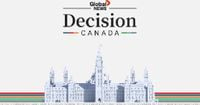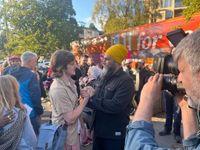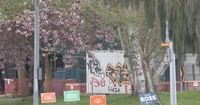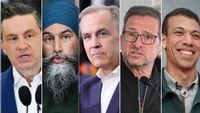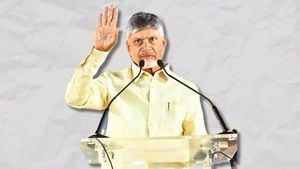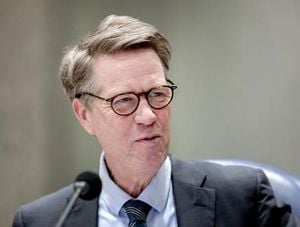As the Canadian federal election approaches, the Saanich-Gulf Islands riding in British Columbia is set to be a battleground, with incumbent Green MP Elizabeth May facing strong competition from Liberal candidate David Beckham, Conservative Cathie Ounsted, and NDP's Colin Plant. Voters will head to the polls on April 28, 2025, to decide who will represent the region, which has been a Green stronghold since May first took office in 2011.
In the last federal election, May secured her position with 24,648 votes, capturing 37.62% of the total votes. However, this election is shaping up to be different, as polls indicate a potential shift in voter sentiment. According to 338Canada, May is at risk of losing her seat to the Conservatives, who are gaining traction in the area.
On a sunny spring Saturday, May was busy engaging with constituents at an Earth Day fair in Saanich before heading to an all-candidates debate at the Saanichton Fairgrounds. Despite being 70 years old, May is known for her energetic presence, often outpacing her younger aides. Her constituency assistant humorously remarked on her relentless pace, noting that it can be challenging to keep up with her.
At the all-candidates meeting, which drew an audience of around 150 to 200 people, the atmosphere was polite but charged. The crowd was predominantly older, reflecting the demographics of the riding. Interestingly, Conservative candidate Cathie Ounsted was absent from the event, a move consistent with her party's reluctance to engage in unscripted encounters with voters. This absence has led to Ounsted being perceived as the "invisible candidate," despite expectations that she could finish in the top two.
In contrast, the Liberal candidate David Beckham, who secured his nomination amid increased interest following Mark Carney's entry into the race, received a warm reception from the audience. Beckham explained that initially, no one wanted the Liberal nomination, but Carney's influence changed the dynamics significantly.
As the debate unfolded, it became clear that many attendees had already made up their minds. A couple in their thirties, who identified themselves as strategic voters, expressed that they were closely following polls and recommendations to guide their choices. This sentiment echoed throughout the room, with many attendees viewing this election as crucial.
Meanwhile, the NDP is also making waves in the region. NDP leader Jagmeet Singh recently visited Victoria, where he was met with enthusiastic support from over 150 fans of incumbent MP Laurel Collins. The event showcased Singh's charisma, which seems to resonate more in person than on screen. Collins, who has a strong background in non-profits, faces a significant challenge from Liberal candidate Will Greaves, whose campaign claims to have mobilized 400 volunteers.
As the election date draws near, the political landscape is becoming increasingly competitive. With the Liberal Party leading in the polls by five points as of April 22, 2025, and the Conservatives gaining ground, the stakes are high for all candidates. The Liberals, under Carney's leadership, have laid out an ambitious platform focusing on uniting Canadians, enhancing military security, and protecting public health care.
In contrast, Conservative leader Pierre Poilievre has promised a radically different approach, emphasizing tax cuts, crime reduction, and a significant budget overhaul. His platform aims to cut the deficit by 70%, eliminate the carbon tax, and implement a three-strike rule for serious crimes.
The NDP, led by Singh, is focusing on healthcare improvements, affordable housing, and environmental initiatives, advocating for policies that would lower costs for everyday Canadians. Their platform also includes a push for electoral reform, proposing to allow 16 and 17-year-olds to vote.
The Green Party, co-led by May, released their platform earlier than the others, emphasizing economic plans, environmental protection, and government reform. Their comprehensive 124-page document outlines strategies for sustainable growth and social equity.
As voters prepare to make their choices, the upcoming election is shaping up to be one of the most significant and divisive in Canada’s history, driven by pressing issues such as the housing crisis, drug-related challenges, and international relations. The dynamics in Saanich-Gulf Islands serve as a microcosm of the broader electoral landscape, with each party vying for support in an increasingly polarized environment.
With election day just around the corner, the candidates are ramping up their efforts to connect with voters, hoping to sway the undecided and solidify their bases. The outcome in Saanich-Gulf Islands could set the tone for the future of Canadian politics, making it a key race to watch in the days leading up to April 28.
